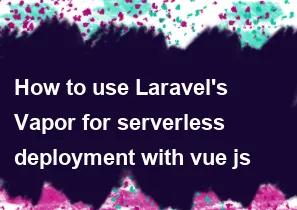How to use Laravel's Vapor for serverless deployment with vue js

Laravel Vapor is a serverless deployment platform for Laravel applications, and it primarily focuses on backend services. If you are using Vue.js for your frontend, you can deploy it separately as a static site to a service like AWS S3 or another suitable hosting provider, and then connect it to your Laravel Vapor backend.
Here's a general guide on how you can deploy a Vue.js frontend with Laravel Vapor:
1. Set up Vue.js project:
Assuming you have a Vue.js project ready, build the project using:
bashnpm run build
This command will generate a dist folder containing your static assets.
2. Choose a Hosting Provider for Vue.js:
You can choose a static site hosting provider like AWS S3, Netlify, Vercel, GitHub Pages, or others. For example, if you choose AWS S3:
- Create an S3 bucket.
- Upload the contents of the
distfolder to the bucket. - Make the bucket publicly accessible.
3. Configure Your Laravel Vapor Project:
Assuming you already have a Laravel Vapor project set up, configure the vapor.yml file to include information about your Vue.js frontend. Add the following to the vapor.yml file:
yamlassets:
- source: /path/to/your/vuejs/dist
target: public
exclude:
- .gitignore
- node_modules
- src
- public
- .env
- .git
- .gitignore
- README.md
Replace /path/to/your/vuejs/dist with the actual path to your Vue.js dist folder.
4. Deploy Your Laravel Vapor Project:
Deploy your Laravel Vapor project with the following command:
bashvapor deploy
This will deploy both your Laravel backend and the Vue.js frontend to the serverless environment.
5. Connect Vue.js to Laravel Backend:
In your Vue.js application, update the API endpoints to point to your Laravel Vapor backend. Ensure that your Laravel backend is set up to handle requests from your frontend.
6. Testing:
Test your deployed application to ensure that the frontend and backend communicate correctly.
Remember, Laravel Vapor is primarily designed for deploying serverless Laravel applications, so you may need to adjust your setup based on the specific requirements of your project.
Make sure to refer to the official Laravel Vapor documentation for any updates or changes:
This guide assumes a basic setup, and your specific requirements may necessitate additional configurations or steps.
-
Popular Post
- How to optimize for Google's About This Result feature for local businesses
- How to implement multi-language support in an Express.js application
- How to handle and optimize for changes in mobile search behavior
- How to handle CORS in a Node.js application
- How to use Vue.js with a UI framework (e.g., Vuetify, Element UI)
- How to configure Laravel Telescope for monitoring and profiling API requests
- How to create a command-line tool using the Commander.js library in Node.js
- How to implement code splitting in a React.js application
- How to use the AWS SDK for Node.js to interact with various AWS services
- How to use the Node.js Stream API for efficient data processing
- How to implement a cookie parser middleware in Node.js
- How to implement WebSockets for real-time communication in React
-
Latest Post
- How to implement a dynamic form with dynamic field styling based on user input in Next.js
- How to create a custom hook for handling user interactions with the browser's device motion in Next.js
- How to create a custom hook for handling user interactions with the browser's battery status in Next.js
- How to implement a dynamic form with dynamic field visibility based on user input in Next.js
- How to implement a dynamic form with real-time collaboration features in Next.js
- How to create a custom hook for handling user interactions with the browser's media devices in Next.js
- How to use the useSWRInfinite hook for paginating data with a custom loading indicator in Next.js
- How to create a custom hook for handling user interactions with the browser's network status in Next.js
- How to create a custom hook for handling user interactions with the browser's location in Next.js
- How to implement a dynamic form with multi-language support in Next.js
- How to create a custom hook for handling user interactions with the browser's ambient light sensor in Next.js
- How to use the useHover hook for creating interactive image zoom effects in Next.js